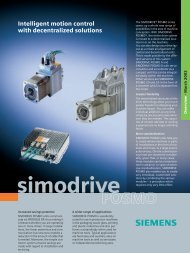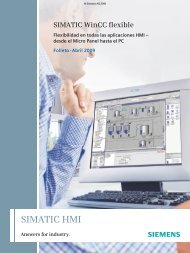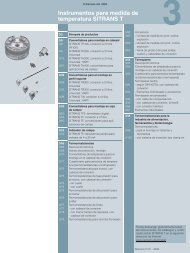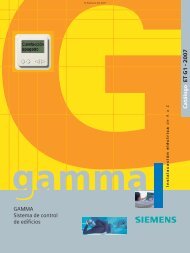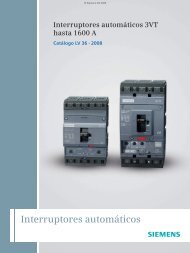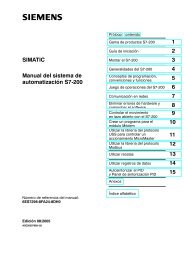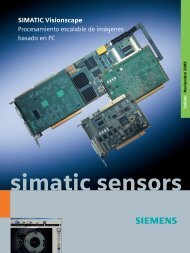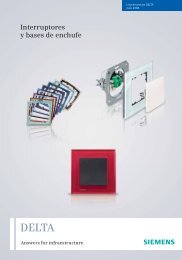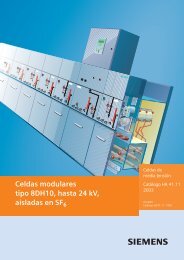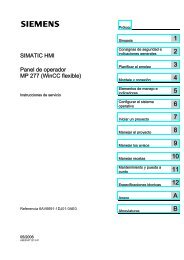Create successful ePaper yourself
Turn your PDF publications into a flip-book with our unique Google optimized e-Paper software.
Appendix<br />
© Siemens AG 2007<br />
Glossary<br />
6<br />
Positive or<br />
enforced operation/actuation<br />
Protection against direct contact<br />
Rated actuating voltage U c<br />
(see also IEC/EN 60947-1; 4.5.1)<br />
Rated breaking capacity<br />
(see also IEC/EN 60947-1; 4.3.5.3)<br />
Rated short-circuit current: I q<br />
(see also IEC/EN 60947-1; 2.5.29/IEV 441-17-20)<br />
Rated control voltage U s<br />
(see also IEC/EN 60947-1; 4.5.1)<br />
Rated current I n (of a circuit-breaker)<br />
(see also IEC/EN 60947-2; 4.3.2.3)<br />
Rated frequency<br />
(see also IEC/EN 60947-1; 4.3.3)<br />
Rated impulse withstand voltage U imp<br />
(see also IEC/EN 60947-1; 4.3.1.3)<br />
Rated insulation voltage U i<br />
(see also IEC/EN 60947-1; 4.3.1.2)<br />
Rated making capacity<br />
(see also IEC/EN 60947-1; 4.3.5.2)<br />
Rated operational current I e<br />
(see also IEC/EN 60947-1; 4.3.2.3)<br />
Rated operational voltage U e<br />
(see also IEC/EN 60947-1; 4.3.1.1)<br />
Rated output power<br />
(see also IEC/EN 60947-1; 4.3.2.3)<br />
Rated service short-circuit breaking capacity I cs<br />
(see also IEC/EN 60947-2; 4.3.5.2.2)<br />
Rated short-circuit breaking capacity I cn<br />
(see also IEC/EN 60947-1; 4.3.6.3)<br />
Rated short-circuit making capacity I cm<br />
(see also IEC/EN 60947-1; 4.3.6.2)<br />
Rated short-time withstand current I cw<br />
(see also IEC/EN 60947-1; 4.3.6.1)<br />
This describes an arrangement where a link between the actuator and<br />
the switching element ensures that the force exerted on the actuator is<br />
transferred directly (without the intervention of sprung parts) onto the<br />
switching element.<br />
Design measures incorporated into equipment in order to prevent<br />
direct contact (i.e. without tools) with live parts of a system (fingersafe,<br />
back-of-hand proof).<br />
The voltage which is applied to the actuating make contact in a control<br />
circuit. Due to the presence in the control circuit of transformers or<br />
resistors, this voltage may differ from the rated control supply voltage.<br />
The r.m.s. value that a switching device is capable of breaking according<br />
to its utilization category. This value refers to the rated operational<br />
voltage and the rated operational current. Equipment must be<br />
capable of breaking any value of current up to and including its rated<br />
breaking capacity stated.<br />
The short-circuit current that a switching device, e.g. a circuit-breaker,<br />
protected by a short-circuit protective device such as a motor-protective<br />
circuit-breaker, can carry for the duration of the tripping delay of the<br />
protective mechanism.<br />
The voltage applied to the input terminals of the control circuit of an<br />
equipment. Due to the presence in the control circuit of transformers or<br />
resistors, this voltage may differ from the rated actuating (control<br />
circuit) voltage.<br />
For circuit-breakers, this current value is equal to the rated uninterrupted<br />
current and the conventional free-air thermal current.<br />
The frequency for which an equipment is designed and to which the<br />
other characteristics are referred.<br />
Measures the stability of the internal clearances of an equipment<br />
against overvoltage peaks. The utilization of suitable switchgear can<br />
ensure that overvoltages are prevented from transferring from the<br />
mains to de-energized system sections within it.<br />
The voltage to which insulation tests and creepage distances of equipment<br />
are referred. The maximum rated operational voltage must not<br />
be higher than the rated insulation voltage.<br />
The value of current that an equipment is capable of switching on in<br />
accordance with the utilization category and the rated operational<br />
voltage.<br />
The current that an equipment is capable of carrying, taking into<br />
account the rated operational voltage, duration of operation, utilization<br />
category and ambient temperature.<br />
The voltage to which the characteristics of an equipment are referred.<br />
The highest rated operational voltage must not be higher than the<br />
rated insulation voltage.<br />
The power output of a motor at the associated rated operational<br />
voltage.<br />
The prospective short-circuit current which, depending on the rated<br />
operational voltage, a circuit-breaker is capable of breaking repeatedly<br />
(test cycle O-CO-CO, previously P-2). After interrupting this shortcircuit<br />
current value, the circuit-breaker must be capable of continuing<br />
to carry and disconnect in the event of overloading, the rated uninterrupted<br />
current, despite its own thermal level having increased.<br />
The maximum value of current that an equipment is capable of switching<br />
off at rated operational voltage and rated frequency, and without<br />
sustaining damage. It is expressed as r.m.s. value.<br />
The maximum value of current that an equipment is capable of switching<br />
on at rated operational voltage and rated frequency, and without<br />
sustaining damage. Unlike for other characteristic values, it is<br />
expressed as maximum prospective peak value.<br />
The short-time withstand current value that the equipment is capable of<br />
carrying for a specified time without damage, e.g. due to excessive<br />
heating.<br />
6/4 Siemens LV 70 · 2006




